DMI – Graduate Course in Computer Science
Copyleft
![]() 2016-2017 Giuseppe Scollo
2016-2017 Giuseppe Scollo
outline:
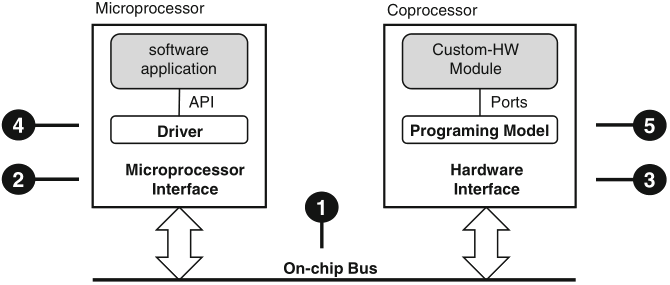
Schaumont, Figure 9.1 - The hardware/software interface
Figure 9.1 presents a synopsis of the elements in a hardware/software interface
the function of the hardware/software interface is to connect the software application to the custom-hardware module; this objective involves five elements:
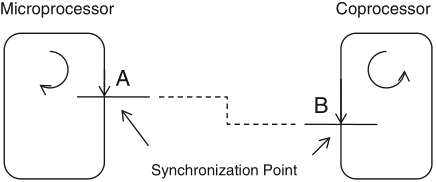
Schaumont, Figure 9.2 - Synchronization point
synchronization: the structured interaction of two otherwise independent and parallel entities
synchronization is needed to support communication between parallel subsystems: every talker needs to have a listener to be heard

Schaumont, Figure 9.3 - Dimensions of the synchronization problem
three orthogonal dimensions of the synchronization problem:
semaphore: a synchronization primitive S to control access over an abstract, shared resource, by operations:

Schaumont, Figure 9.4 - Synchronization with a single semaphore
int shared_data;
semaphore S1;
entity one {
P(S1);
while (1) {
short_delay();
shared_data = ...;
V(S1);
// synchronization point
}
}
entity two {
short_delay();
while (1) {
P(S1);
// synchronization point
received_data = shared_data;
}
}
Schaumont, Listing 9.1 - One-way synchronization with a semaphore
synchronization points: when entity one calls V(S1), so unlocking the stalled entity two
just assume the opposite, viz. move the short_delay() function call from the while-loop in entity one to the while-loop in entity two ...
the situation of unknown delays can be addressed with a two-semaphore scheme

Schaumont, Figure 9.5 - Synchronization with two semaphores
int shared_data;
semaphore S1, S2;
entity one {
P(S1);
while (1) {
variable_delay();
shared_data = ...;
V(S1); // synchronization point 1
P(S2); // synchronization point 2
}
}
entity two {
P(S2);
while (1) {
variable_delay();
P(S1); // synchronization point 1
received_data = shared_data;
V(S2); // synchronization point 2
}
}
Schaumont, Listing 9.2 - Two-way synchronization with two semaphores
figure 9.5 illustrates the case where:
in parallel systems, a centralized semaphore may not be feasible; a common alternative is
if a sender or receiver arrives too early at a synchronization point, should it wait idle until the proper condition comes along, or should it go off and do something else?
both of the semaphore and handshake schemes discussed earlier implement a blocking data-transfer
computational speedup is often the motivation for the design of custom hardware
communication constraints need to be evaluated as well!
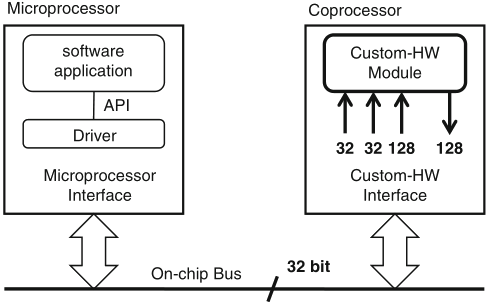
Schaumont, Figure 9.8 - Communication constraints of a coprocessor
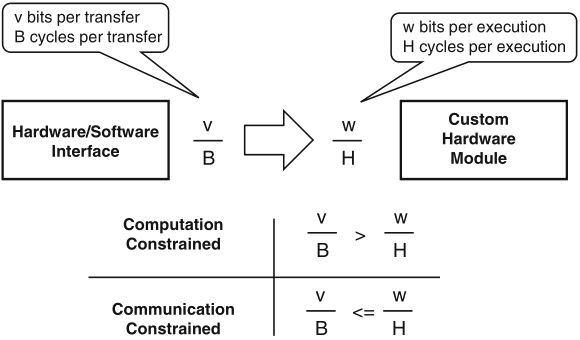
Schaumont, Figure 9.9 - Communication-constrained system vs. computation-constrained system
the number of clock cycles needed per execution of the custom hardware module is related to its hardware sharing factor (HSF) =def number of available clock cycles in between each I/O event
| Architecture | HSF |
| Systolic array processor | 1 |
| Bit-parallel processor | 1–10 |
| Bit-serial processor | 10–100 |
| Micro-coded processor | >100 |
Schaumont, Table 9.1 - Hardware sharing factor
coupling indicates the level of interaction between execution flows in software and custom hardware
coupling relates synchronization with performance
| Coprocessor | Memory-mapped | |
| Factor | interface | interface |
| Addressing | Processor-specific | On-chip bus address |
| Connection | Point-to-point | Shared |
| Latency | Fixed | Variable |
| Throughput | Higher | Lower |
Schaumont, Table 9.2 - Comparing a coprocessor interface with a memory-mapped interface
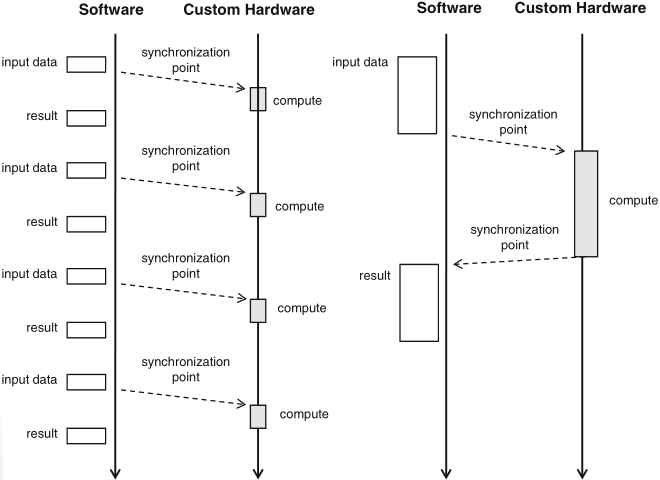
Schaumont, Figure 9.10 - Tight coupling versus loose coupling
example: difference between
N.B.: a high degree of parallelism in the overall design may be easier to achieve with a loosely-coupled scheme than with a tightly-coupled scheme